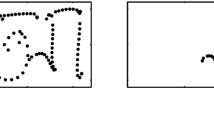Abstract
For character recognition in document analysis, some classes are closely overlapped but are not necessarily to be separated before contextual information is exploited. For classification of such overlapping classes, either discriminating between them or merging them into a metaclass does not satisfy. Merging the overlapping classes into a metaclass implies that within-metaclass substitution is considered as correct classification. For such classification problems, this paper proposes a partial discriminative training (PDT) scheme, in which, a training pattern of an overlapping class is used as a positive sample of its labeled class, and neither positive nor negative sample for its allied classes (those overlapping with the labeled class). In experiments of offline handwritten letter and online symbol recognition using various classifiers evaluated at metaclass level, the PDT scheme mostly outperforms ordinary discriminative training and merged metaclass classification.
Similar content being viewed by others
References
Lu B.-L., Ito M.: Task decomposition and modular combination based on class relations: a modular neural network for pattern classification. IEEE Trans. Neural Netw. 10(5), 1244–1256 (1999)
Podolak I.T.: Hierarchical classifier with overlapping class groups. Expert Syst. Appl. 34(1), 673–682 (2008)
Zhou J., Krzyzak A., Suen C.Y.: Verification—a method of enhancing the recognizers of isolated and touching handwritten numerals. Pattern Recognit. 35(5), 1179–1189 (2002)
Bellili A., Gilloux M., Gallinari P.: An MLP–SVM combination architecture for offline handwritten digit recognition: reduction of recognition errors by support vector machines rejection mechanisms. Int. J. Document Anal. Recognit. 5(4), 244–252 (2003)
Boutell M.R., Luo J., Shen X., Browm C.M.: Learning multi-label scene classification. Pattern Recognit. 37(9), 1757–1771 (2004)
Tsoumakas G., Katakis I.: Multi-label classification: an overview. Int. J. Data Warehousing Min. 3(3), 1–13 (2007)
Camastra, F., Spinetti, M., Vinciarelli, A.: Offline cursive character challenge: a new benchmark for machine learning and pattern recognition algorithms. In: Proceedings of 18th ICPR, Hong Kong, vol. 2, pp. 913–916 (2006)
Camastra F.: A SVM-based cursive character recognizer. Pattern Recognit. 40(12), 3721–3727 (2007)
Nakagawa M., Matsumoto K.: Collection of on-line handwritten Japanese character pattern databases and their analysis. Int. J. Document Anal. Recognit. 7(1), 69–81 (2004)
Liu C.-L., Nakagawa M.: Evaluation of prototype learning algorithms for nearest neighbor classifier in application to handwritten character recognition. Pattern Recognit. 34(3), 601–615 (2001)
Liu C.-L., Sako H., Fujisawa H.: Discriminative learning quadratic discriminant function for handwriting recognition. IEEE Trans. Neural Netw. 15(2), 430–444 (2004)
Fukunaga K.: Introduction to Statistical Pattern Recognition. Academic Press, New York (1990)
Bishop C.M.: Neural Networks for Pattern Recognition. Oxford University Press, New York (1995)
Burges C.J.C.: A tutorial on support vector machines for pattern recognition. Knowl. Discov. Data Min. 2(2), 1–43 (1998)
Koerich, A.L.: Unconstrained handwritten character recognition using different classification strategies. In: Gori, M., Marinai, S. (eds.) Proceedings of 1st IAPR Workshop on Artificial Neural Networks in Pattern Recognition, pp. 52–56 (2003)
Blumenstein M., Liu X.Y., Verma B.: An investigation of the modified direction feature for cursive character recognition. Pattern Recognit. 40(2), 376–388 (2007)
Liu, C.-L.: Partial discriminative training of neural networks for classification of overlapping classes. In: Artificial Neural Networks in Pattern Recognition: Third IAPR Workshop, Paris, France, LNAI, vol. 5064, pp. 137–146. Springer, Heidelberg (2008)
Juang B.-H., Katagiri S.: Discriminative learning for minimum error classification. IEEE Trans. Signal Process. 40(12), 3043–3054 (1992)
Shürmann J.: Pattern Classification: A Unified View of Statistical and Neural Approaches. Wiley Interscience, New York (1996)
Kreßel, U., Schürmann, J.: Pattern classification techniques based on function approximation. In: Bunke, H., Wang, P.S.P. (eds.) Handbook of Character Recognition and Document Image Analysis, pp. 49–78. World Scientific, Singapore (1997)
Liu C.-L., Sako H.: Class-specific feature polynomial classifier for pattern classification and its application to handwritten numeral recognition. Pattern Recognit. 39(4), 669–681 (2006)
Kimura F., Takashina K., Tsuruoka S., Miyake Y.: Modified quadratic discriminant functions and the application to Chinese character recognition. IEEE Trans. Pattern Anal. Mach. Intell. 9(1), 149–153 (1987)
Liu C.-L., Sako H., Fujisawa H.: Effects of classifier structures and training regimes on integrated segmentation and recognition of handwritten numeral strings. IEEE Trans. Pattern Anal. Mach. Intell. 26(11), 1395–1407 (2004)
Camastra F., Vinciarelli A.: Cursive character recognition by learning vector quantization. Pattern Recognit. Lett. 22(6-7), 625–629 (2001)
Liu C.-L., Nakashima K., Sako H., Fujisawa H.: Handwritten digit recognition: benchmarking of state-of-the-art techniques. Pattern Recognit. 36(10), 2271–2285 (2003)
Liu C.-L., Nakashima K., Sako H., Fujisawa H.: Handwritten digit recognition: investigation of normalization and feature extraction techniques. Pattern Recognit. 37(2), 265–279 (2004)
Dietterich T.G.: Approximate statistical test for comparing supervised classification learning algorithms. Neural Comput. 7(10), 1895–1924 (1998)
Liu, C.-L., Zhou, X.-D.: Online Japanese character recognition using trajectory-based normalization and direction feature extraction. In: Proceedings of 10th IWFHR, La Baule, France, pp. 217–222 (2006)
Author information
Authors and Affiliations
Corresponding author
Additional information
This work was supported by the Hundred Talents Program of Chinese Academy of Sciences and the National Natural Science Foundation of China (NSFC) under Grants No. 60775004 and No. 60723005.
Rights and permissions
About this article
Cite this article
Liu, CL. Partial discriminative training for classification of overlapping classes in document analysis. IJDAR 11, 53–65 (2008). https://doi.org/10.1007/s10032-008-0069-1
Received:
Revised:
Accepted:
Published:
Issue Date:
DOI: https://doi.org/10.1007/s10032-008-0069-1




